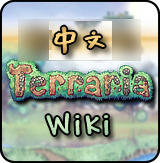(同步en更新,待翻译) |
Jackson IH(留言 | 贡献) 小 (添加至分类:待翻译条目) 标签:源代码编辑 |
||
| 第1行: | 第1行: | ||
| + | {{Translation|needed}} |
||
'''放置'''的[[{{tr|item}}]]是指那些已经变成世界固定部分、需要用[[{{tr|Tool}}]]才能释放并拾取的物品。这与[[{{tr|inventory}}]]{{tr|items}}或掉落的{{tr|items}}形成对比。{{tr|Items}}可以由游戏“天然放置”,这通常发生在世界一开始生成时。{{tr|Items}}也可以由{{tr|the player}}放置:当玩家建造建筑时,他们是在''放置''{{tr|items}},诸如[[{{tr|Blocks}}]]和[[{{tr|Furniture}}]]。 |
'''放置'''的[[{{tr|item}}]]是指那些已经变成世界固定部分、需要用[[{{tr|Tool}}]]才能释放并拾取的物品。这与[[{{tr|inventory}}]]{{tr|items}}或掉落的{{tr|items}}形成对比。{{tr|Items}}可以由游戏“天然放置”,这通常发生在世界一开始生成时。{{tr|Items}}也可以由{{tr|the player}}放置:当玩家建造建筑时,他们是在''放置''{{tr|items}},诸如[[{{tr|Blocks}}]]和[[{{tr|Furniture}}]]。 |
||
2021年7月28日 (三) 12:44的版本
放置的物品是指那些已经变成世界固定部分、需要用工具才能释放并拾取的物品。这与物品栏物品或掉落的物品形成对比。物品可以由游戏“天然放置”,这通常发生在世界一开始生成时。物品也可以由玩家放置:当玩家建造建筑时,他们是在放置物品,诸如物块和家具。
前景放置 vs 背景放置


A character standing over a Bookcase (background).
As far as the player experience goes, placed items fall into several "layers" laid over the map, with a little overlap; the most obvious distinction is that the first layer represents "foreground" objects that can block the player's movement, while the others represent various "background" layers, with little or no effect on the player's passage.
- Placed foreground objects: A foreground object is something that collides with the character and inhibits movement. The vast majority of these are blocks, and in turn nearly all blocks are placed in the foreground layer. There are a few non-blocks in the foreground layer, such as Boulders and Teleporters, and a few objects (e.g. Doors, platforms) that can interact with both this and the next layer. Thorny bushes and their variants are among the few plants in the foreground, but Living Trees are also made of foreground blocks.
- Actuators can turn most foreground objects into background ones (and back again) but actuators cannot force a "native" background object into the foreground. The Active/Inactive Stone Block has the ability to shift between foreground and background state when prompted by wire signals.
- A background object is something that doesn't collide with characters, but cannot share a tile with a foreground block. (This is sometimes called the "furniture layer".) Characters can move through them freely. These include the majority of plants (trees, vines, tall grass, etc), and almost all furniture. Many background objects are for visual appeal only, though several, such as crafting stations and storage items, have functions for the player.
- Some objects possess qualities of both the foreground and furniture. Doors are foreground objects when closed and background ones when open. Some furniture (especially Platforms) are mainly background objects, but a character can stand on top of them. (Pressing the ▼ Down key causes the character to "jump down" by falling through.) Aside from platforms, many of the "flat surface" furniture items act like this: Workbenches, Tables, and the like. Bubble blocks act like solid blocks with respect to liquids, but otherwise as furniture items.
- Liquids occupy their own layer: While they normally flow around blocks and can't be placed in them, blocks can be placed in liquids (except lava) and the liquid is then trapped but not destroyed. A few furniture objects can similarly trap liquids (chests), but normally liquids can flow through background objects, perhaps breaking them in passage. Liquids will slow the passage of characters and most projectiles. With appropriate accessories or buffs, players can walk on the surface of a liquid as if it were a platform. Liquids can partly or completely hide furniture-layer items they cover, as well as characters or enemies within them.
- Walls do not impede objects on any other layer, but they can provide "support" for placing foreground or background objects. Otherwise they do not interact with other layers, and are depicted behind everything except the biome-dependent "scenery" images. Natural walls can affect biome determination and enemy spawning, and in some cases they can participate in biome spreading.
- The "wiring layer" contains wire and actuators; these can overlap and interact with foreground or background objects, and never collide with the character or other entities. They are not visible unless the player is either wielding a mechanism-related object, or else using a Mechanical Lens or The Grand Design. When such wiring objects are visible, they are not concealed by objects on any other layer. Note that most other mechanisms are either foreground objects or background furniture.
如何放置
有两种放置物品的方法:
- 如果自动暂停处于关闭状态且你的物品栏处于打开状态,从物品栏中拿起物品并在你要放置此物品的地方按⚒ Use / Attack键。
- 无论是否开启了自动暂停,如果一件物品处于物品栏的热键栏中,就像选择武器或工具那样选择它,然后在你要放置此物品的地方按⚒ Use / Attack键。
无论哪种情况下,都必须在鼠标光标放在放置指定物品的恰当位置时进行此操作,并且你的人物必须位于放置位置周围几格距离内。
例如,大多数家具物品,比如工作台,必须放置在至少 3 物块宽的平坦表面上。在热键栏中选择工作台物品后,将鼠标光标移动到相对较长、平坦、且已清除所有其他物品(包括草)的表面上方,然后按⚒ Use / Attack键。
To free an item and pick it up again, you normally use a Pickaxe. As a special case, natural trees (including cactus and giant mushrooms) require use of an axe to harvest them. Note that anything requiring an axe to harvest cannot be directly placed by the player.
对于具有左/右方向的物品,比如床和椅子,放置时角色面朝的方向决定了物品的放置方式。
放置要求
- 物品必须是“可放置”的。大多数(但并非全部)物品都是可放置的。物品是否可放置在游戏中通过其工具提示指明;当你将鼠标光标停留在物品上时显示“可放置”的物品即为可放置的。
- 放置区域必须适合指定物品。物块可以放置在和任意其他物块相邻的空白空间中,家具物品却通常会有更加严格的放置要求。大多数需要有坚固、平坦的表面,但有些要求更宽松(比如火把),或者会有更严苛(比如门或蜡烛)。在 1.3.0.1 更新以后,用"界面"选项中的“放置预览”选项可以更轻松地找到合适的放置区域。
放置的家具物品的功能
- 放置的制作站,比如工作台和砧,当人物站在它们附近时能扩充玩家的制作菜单。打开物品栏(Inventory)后可以在屏幕左下角看到当前的制作选项。用鼠标滚轮滚动可制作的物品。根据当时角色附近有哪些制作站,会出现不同的制作选项。
- Placed storage items allow you to store and retrieve items by using them with the ⚷ Open / Activate key. Any Dresser will also give access to a menu affecting player appearance.
- 放置的背景墙将允许 NPC 搬入建筑物中,并且在很多情况下,会防止敌怪在建筑物中生成。更多这方面的细节,参见 NPC 和房屋。
- 放置的背景墙也可以让一些家具放置其上,比如开关、控制杆和火把。
- 放置的床让玩家能够设置他们自己的生成点。
Template:游戏机制
